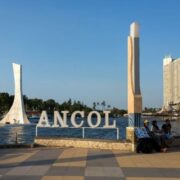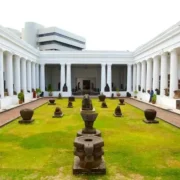
Your Guide to Visiting the National Gallery of Indonesia: A Cultural Hub in Jakarta
The National Gallery of Indonesia stands as a beacon of cultural pride and artistic expression in the heart of Jakarta. Established to preserve and promote the country’s rich artistic heritage, this renowned art museum has become a key landmark for art enthusiasts, historians, and tourists alike. It is a space where the past and present converge, celebrating the diversity of Indonesia’s artistic traditions while offering a glimpse into its modern creativity.
As one of Jakarta’s premier attractions, the gallery is dedicated to showcasing a vast collection of artworks, from traditional Indonesian pieces to contemporary masterpieces. With its mission to foster a deeper appreciation for Indonesia’s cultural heritage, the gallery plays a vital role in highlighting the evolution of the nation’s art and its profound connection to society. The exhibits reflect the vibrancy of the Jakarta art scene while also drawing attention to the global significance of Indonesian artistry.
The National Gallery of Indonesia is more than just an art museum; it is a cultural hub that bridges generations and inspires creativity. For visitors, it offers an unparalleled opportunity to explore Indonesia’s art gallery scene and experience the country’s diverse cultural tapestry. Whether you’re a casual visitor or a devoted art lover, this institution provides an enriching experience that highlights the essence of Indonesian identity and creativity.
Table of Contents
ToggleThe History and Establishment of the National Gallery of Indonesia
The National Gallery of Indonesia has a rich history that reflects the nation’s commitment to preserving and promoting its artistic and cultural heritage. Officially inaugurated in 1999, the gallery was established as a dedicated institution to house and showcase Indonesian art across different eras. Its founding marked a pivotal moment in Jakarta’s cultural development, providing a permanent space for art enthusiasts to explore the evolution of creativity in Indonesia.
The gallery’s inception can be traced back to earlier initiatives aimed at preserving cultural heritage and encouraging the appreciation of art within Indonesian society. The gallery’s inception was supported by collaborations between the government, local artists, and cultural organizations, all united by a shared vision of celebrating and preserving the nation’s artistic identity. Over the years, the National Gallery of Indonesia has grown into an esteemed institution, hosting numerous exhibitions, workshops, and events that contribute to the vibrant art scene in Jakarta.
A significant milestone in the gallery’s journey was the restoration of its main building, a historic structure originally constructed in the early 20th century. This architectural gem is a testament to the blending of art preservation and historical conservation, offering visitors not only stunning exhibits but also a glimpse into the colonial architecture of Jakarta’s past.
The National Gallery of Indonesia plays a vital role in the preservation and promotion of Indonesian art, housing a vast collection of works that span traditional, modern, and contemporary styles. Through its exhibitions and educational programs, the gallery ensures that the nation’s artistic legacy is celebrated and passed down to future generations. It serves as a reminder of the enduring value of art in shaping cultural identity and fostering creativity in Indonesia.
For art lovers and history enthusiasts, the gallery is a treasure trove of cultural heritage and inspiration, making it an essential destination for anyone seeking to understand the depth and diversity of Indonesia’s artistic traditions.
The Architectural Design of the National Gallery of Indonesia
The National Gallery of Indonesia stands as a striking cultural landmark in Jakarta, blending historical and modern architectural elements that embody the nation’s rich artistic heritage. Its design reflects not only the beauty of Indonesian architecture but also its role as a space dedicated to preserving and showcasing the country’s art and culture.
Historical Roots in the Building’s Architecture
The main building of the National Gallery of Indonesia is housed in a historic colonial-era structure, originally constructed in the early 20th century. This iconic building features Jakarta landmarks of the colonial period, such as high ceilings, large windows, and symmetrical layouts, which create a sense of grandeur and openness. These architectural elements not only offer a historical connection to Jakarta’s past but also provide a serene and welcoming atmosphere for visitors exploring the gallery.
Modern Additions to Complement Traditional Design
To meet the evolving needs of its growing audience, the National Gallery of Indonesia has incorporated modern architectural features while preserving its historical essence. The seamless integration of building design innovations, such as minimalist gallery spaces and advanced lighting systems, enhances the display of artworks. These additions ensure that the gallery remains a state-of-the-art facility, while still respecting its roots in Indonesian architecture.
How the Architecture Enhances the Visitor Experience
The layout of the gallery is carefully designed to guide visitors through its exhibits in a logical and immersive manner. Open spaces, interconnected rooms, and strategically placed viewing areas highlight the gallery’s commitment to offering an engaging experience. The architecture fosters an intimate connection between the audience and the art on display, further solidifying the gallery’s status as a cultural hub.
A Cultural Landmark in Jakarta
As one of the most prominent cultural landmarks in Jakarta, the National Gallery of Indonesia represents more than just an art museum; it symbolizes the nation’s dedication to preserving its cultural identity. The architectural design, combining historical and modern influences, underscores the gallery’s mission to bridge Indonesia’s artistic past and future.
In conclusion, the architectural design of the National Gallery of Indonesia plays a crucial role in establishing it as a standout venue in Jakarta’s cultural landscape. Its thoughtful blend of gallery design elements enhances the visitor experience, ensuring that the gallery remains a must-visit destination for art lovers and cultural enthusiasts alike.
How to Visit the National Gallery of Indonesia
Planning a visit to the National Gallery of Indonesia is an enriching experience for art and culture enthusiasts. This comprehensive guide will provide you with all the necessary details, from ticket prices and opening hours to practical tips for making the most of your visit.
1. Admission Details
Ticket Prices and General Admission
One of the great features of the National Gallery of Indonesia is that entry is generally free for all visitors. This makes it an accessible destination for both locals and tourists alike. However, for special exhibitions or events, there may be a small admission fee. To stay updated on ticket prices for such occasions, it’s best to check the official website or social media pages of the gallery.
Opening Hours
The gallery operates seven days a week, from Monday to Sunday, and is typically open from 9:00 AM to 7:00 PM. It is closed on public holidays to allow for maintenance and exhibit preparations. Make sure to plan your visit within these hours to fully enjoy the exhibits without feeling rushed.
Best Times to Visit
For a more relaxed experience, it’s advisable to visit the National Gallery of Indonesia on weekdays, as weekends tend to attract larger crowds. The early morning hours, right after the gallery opens, are especially ideal for enjoying the art in a tranquil setting. Visitors who prefer a livelier atmosphere can opt to visit during weekends or special events, which often include art workshops and cultural performances.
2. Tips for Tourists
How to Get There
The National Gallery of Indonesia is conveniently located in Central Jakarta, near prominent landmarks like the National Monument (Monas). It is easily accessible via public transportation, including TransJakarta buses and commuter trains. For those driving, parking is available near the venue, though spaces may be limited during peak hours.
What to Bring and Expect
Visitors are encouraged to bring a camera or smartphone to capture memorable moments (where photography is permitted). Comfortable shoes are a must, as exploring the gallery can involve a fair bit of walking. Additionally, make sure to bring a notebook if you’re keen on jotting down insights from the exhibits.
Nearby Attractions
After exploring the gallery, consider visiting nearby attractions such as Monas, Istiqlal Mosque, or the vibrant Jalan Surabaya Antique Market. These destinations complement the cultural experience offered by the National Gallery of Indonesia, making for a well-rounded day in Jakarta.
Visiting the National Gallery of Indonesia is an excellent way to immerse yourself in Indonesia’s artistic and cultural heritage. By following these practical tips, you’ll ensure a smooth and enjoyable experience, leaving you with a deeper appreciation for the nation’s art and history.
The Role of the National Gallery in Promoting Indonesian Art
The National Gallery of Indonesia plays a pivotal role in the growth and recognition of Indonesian art, both locally and internationally. Through various programs and collaborations, it serves as a platform for emerging artists and fosters a thriving art community in Jakarta.
1. Supporting Emerging Artists and Local Art Communities
Nurturing New Talent
The National Gallery of Indonesia actively supports emerging Indonesian artists by providing opportunities to showcase their work in exhibitions. These events allow young and aspiring artists to gain visibility, connect with art enthusiasts, and establish their presence in the art community of Jakarta.
Empowering Local Art Communities
The gallery also works closely with local art communities, offering them a venue to organize workshops, discussions, and other creative events. By fostering such interactions, the gallery not only promotes local art but also strengthens the bonds within the community, ensuring a sustainable ecosystem for Indonesian artists.
2. Collaborations with Art Organizations
Partnerships with National Art Institutions
The National Gallery of Indonesia collaborates with various Indonesian art institutions to celebrate and preserve the nation’s artistic heritage. Joint exhibitions and projects highlight traditional and contemporary art, bringing the richness of Indonesian culture to a broader audience.
International Art Collaborations
In addition to local efforts, the gallery has forged partnerships with international art organizations to promote Indonesian art globally. Through cross-cultural exhibitions, exchange programs, and artist residencies, the gallery ensures that the art of Indonesia gains recognition on the world stage.
Promoting Art Education
Education is another pillar of the gallery’s mission. Through educational programs, such as lectures, guided tours, and interactive workshops, the National Gallery of Indonesia introduces visitors to the history and significance of Indonesian art. These initiatives inspire a new generation to appreciate and create art, reinforcing the gallery’s role as a hub for artistic growth.
The National Gallery of Indonesia is more than just a museum; it is a beacon for promoting local art, empowering Indonesian artists, and fostering global connections. Its commitment to supporting emerging talent, engaging with the art community, and forming international collaborations has solidified its position as a cornerstone of Indonesia’s vibrant art scene.
Discover More of Jakarta with the Ekaputra Tour
After immersing yourself in the rich artistic heritage at the National Gallery of Indonesia, why not continue your cultural journey with Ekaputra Tour’s Jakarta Half-Day Tour? This curated experience offers a visit to iconic landmarks such as Merdeka Square, the National Monument, Istiqlal Mosque, and the historic Old Town Batavia, providing a comprehensive glimpse into Jakarta’s vibrant history and culture.
Ekaputra Tour is dedicated to delivering high-quality services, ensuring your exploration of Jakarta is both informative and enjoyable. To learn more about their offerings and plan your next adventure, visit the Ekaputra tour website now!



